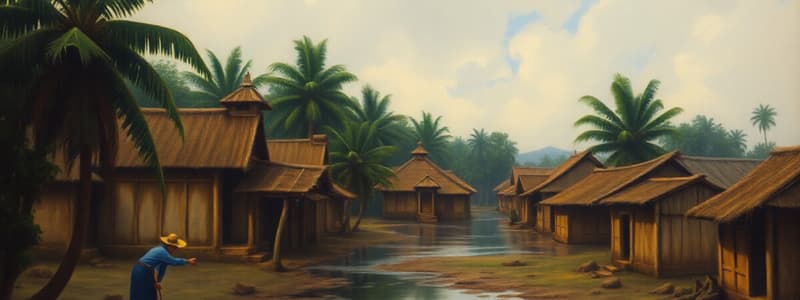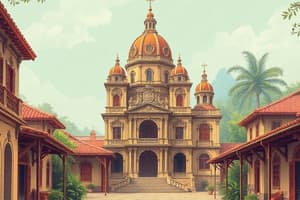Podcast
Questions and Answers
What is a characteristic feature of megalithic structures?
What is a characteristic feature of megalithic structures?
Megalithic structures are known for their incorporation of extensive written records.
Megalithic structures are known for their incorporation of extensive written records.
False
What type of evidence is often associated with megalithic structures?
What type of evidence is often associated with megalithic structures?
Physical evidences
Megalithic structures are primarily characterized by their absence of __________ documents.
Megalithic structures are primarily characterized by their absence of __________ documents.
Signup and view all the answers
Match the following features with their descriptions:
Match the following features with their descriptions:
Signup and view all the answers
What best describes the evidence associated with megalithic structures?
What best describes the evidence associated with megalithic structures?
Signup and view all the answers
Megalithic structures are known for having extensive written documents.
Megalithic structures are known for having extensive written documents.
Signup and view all the answers
What type of structures are characterized by the absence of written documents?
What type of structures are characterized by the absence of written documents?
Signup and view all the answers
Megalithic structures are often studied for their __________ evidence.
Megalithic structures are often studied for their __________ evidence.
Signup and view all the answers
Match the following terms with their descriptions:
Match the following terms with their descriptions:
Signup and view all the answers
Study Notes
Pre-Colonial Philippines
- Absence of written documents
- Evidence gathered from physical remains, specifically megalithic structures
- Population at the time of conquest was estimated at 750,000
- Social unit was the barangay, derived from the Malay term balangay
- Settlements were typically located near coastal or riverine areas
- Settlements were made of renewable materials, considered temporary shelters rather than permanent homes
- Government was organized into barangays, each comprised of 30–100 houses
- No central or national government
- Ruled by a chieftain or datu
- The chieftain promoted the welfare and interests of their subjects; played a significant role in wartime, voyages, farming, and even the construction of their homes
- Tribute was called buwis, in the form of crops
- Chieftains were not absolute rulers; their authority stemmed from demonstrated prowess
- The chieftain was not the only authority figure; other figures of authority existed
- Social classes included datus/leaders; maharlika /free people; timawa /ordinary people, and alipin/slaves
- Datus were highly respected and made crucial decisions, seen as saviors
- Maharlika did not pay taxes and accompanied the datu
- Timawa could live in other barangays
- Alipin were the lowest ranking people; subjected to certain conditions such as inheritance, capture, punishment, and sale
Laws
- Two types exist: customary and written laws
- Customary laws were passed down through verbal communication, comprising most laws within the barangay
- Written laws were issued by the chieftain and council of elders, and announced by the umalohan, or public announcer
- Judicial process involved trials before the datu, acting as judge, and a council of elders, or jury
Judicial Process
- Trials were held before the datu, who acted as judge, with the council of elders acting as jurors
- An oath was used in the judicial process
- "May the crocodile devour me if I lie"
- "May lightning strike me if I give a wrong statement"
- "May I die where I am standing if I am not telling the truth"
- Trial by ordeal was another method used, appealing to divine power for determination of guilt or innocence
Subsistence Economy
- Economy was primarily agricultural, based on rice cultivation
- Other key crops included roasted bananas, sweet potatoes (called oropisa), yams, and camotes (whose leaves were eaten boiled)
Clothing and Ornaments
- Men wore short-sleeved, collarless jackets reaching below the waist; jacket color was significant
- Chiefs wore red
- Others wore blue or black
- The lower portion of clothing involved a cloth wrapped around the waist, exposing the thighs and legs (called Bahag)
- Headwear (Putong) consisted of a cloth wrapped around the head
- A red headdress signified a man had killed a man in war; embroidered headdresses denoted seven deaths in battle
- Necklaces, armlets (kalombiga), earrings, rings, and anklets were also common adornments. Often crafted from gold or precious stones
- Women wore a baro (sleeved jacket) and tapis (wrapped cloth)
- Gem-studded bracelets, necklaces, rings, and gold earrings were common female adornments
- Tattoos were also worn, particularly in the Visayas Islands
Religion
- Bathala was the supreme god of the pre-Spanish Filipinos
- Lesser gods and goddesses were also worshiped
- Idols were revered as objects of worship
- Animism played a role in religious practice
Customs and Beliefs
- Pagnganga involved chewing the areca nut, lime, and a betel leaf
- Variations in names existed across different groups, e.g., nganga (Tagalog), buyo (Visayan), and makan sirek (Malays/Indians)
- Tobacco was sometimes incorporated into the mix
- Beliefs surrounding the afterlife differed between groups
- T'boli believed the soul/spirit left the body during sleep through astral projection; a person is only awakened after the return of the spirit; death occurs when the soul cannot return to the body
- Bagobo believed in two souls, good and evil
- Burial practices varied significantly among different groups
- Manobos buried the dead in trees using multiple methods
- Sulod buried the body inside a tree trunk, removing the bones and placing them in jars
- Ifugaos seated the corpse in a chair for several days before relocating it to caves and then burying them elsewhere
- Sagada people hung the bodies by the side of mountains
- In general, there were other customs such as embedding herbs and oils/perfumes during the embalming process placing the body in a coffin, burying the body beneath houses or cliff caves overlooking the sea
Foreign Influences
- There was evidence of trade and interaction with foreign groups, such as Chinese traders (depicted in illustrations)
Studying That Suits You
Use AI to generate personalized quizzes and flashcards to suit your learning preferences.
Related Documents
Description
Explore the social structure, governance, and settlements in pre-colonial Philippines. This quiz delves into the barangay system, the role of chieftains, and the lifestyle of the indigenous population prior to colonization. Test your knowledge of this rich historical period.




